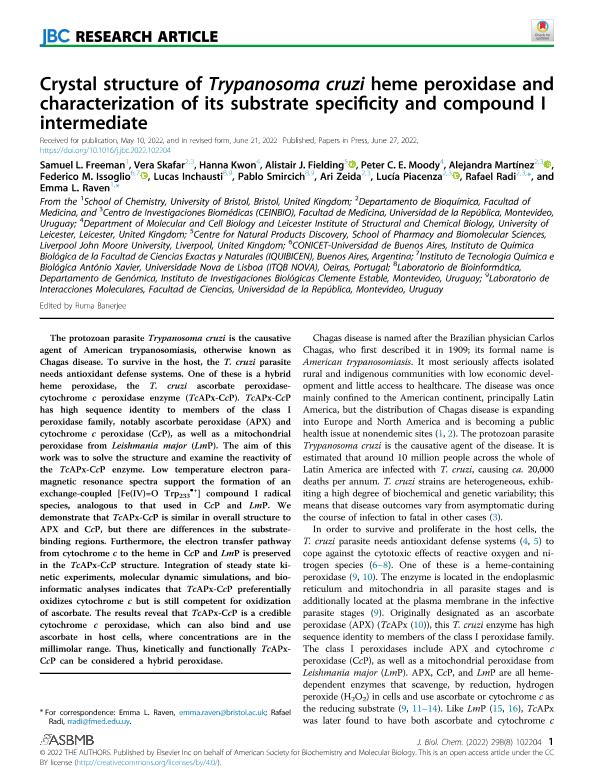Mostrar el registro sencillo del ítem
dc.contributor.author
Freeman, Samuel L.
dc.contributor.author
Skafar, Vera
dc.contributor.author
Kwon, Hanna
dc.contributor.author
Fielding, Alistair J.
dc.contributor.author
Moody, Peter C.E.
dc.contributor.author
Martínez, Alejandra
dc.contributor.author
Issoglio, Federico Matías

dc.contributor.author
Inchausti, Lucas
dc.contributor.author
Smircich, Pablo
dc.contributor.author
Zeida, Ari
dc.contributor.author
Piacenza, Lucía
dc.contributor.author
Radi, Rafael

dc.contributor.author
Raven, Emma L.
dc.date.available
2023-10-12T13:18:17Z
dc.date.issued
2022-08
dc.identifier.citation
Freeman, Samuel L.; Skafar, Vera; Kwon, Hanna; Fielding, Alistair J.; Moody, Peter C.E.; et al.; Crystal structure of Trypanosoma cruzi heme peroxidase and characterization of its substrate specificity and compound I intermediate; American Society for Biochemistry and Molecular Biology; Journal of Biological Chemistry (online); 298; 8; 8-2022; 1-10
dc.identifier.issn
0021-9258
dc.identifier.uri
http://hdl.handle.net/11336/214995
dc.description.abstract
The protozoan parasite Trypanosoma cruzi is the causative agent of American trypanosomiasis, otherwise known as Chagas disease. To survive in the host, the T. cruzi parasite needs antioxidant defense systems. One of these is a hybrid heme peroxidase, the T. cruzi ascorbate peroxidase-cytochrome c peroxidase enzyme (TcAPx-CcP). TcAPx-CcP has high sequence identity to members of the class I peroxidase family, notably ascorbate peroxidase (APX) and cytochrome c peroxidase (CcP), as well as a mitochondrial peroxidase from Leishmania major (LmP). The aim of this work was to solve the structure and examine the reactivity of the TcAPx-CcP enzyme. Low temperature electron paramagnetic resonance spectra support the formation of an exchange-coupled [Fe(IV)=O Trp233•+] compound I radical species, analogous to that used in CcP and LmP. We demonstrate that TcAPx-CcP is similar in overall structure to APX and CcP, but there are differences in the substrate-binding regions. Furthermore, the electron transfer pathway from cytochrome c to the heme in CcP and LmP is preserved in the TcAPx-CcP structure. Integration of steady state kinetic experiments, molecular dynamic simulations, and bioinformatic analyses indicates that TcAPx-CcP preferentially oxidizes cytochrome c but is still competent for oxidization of ascorbate. The results reveal that TcAPx-CcP is a credible cytochrome c peroxidase, which can also bind and use ascorbate in host cells, where concentrations are in the millimolar range. Thus, kinetically and functionally TcAPx-CcP can be considered a hybrid peroxidase.
dc.format
application/pdf
dc.language.iso
eng
dc.publisher
American Society for Biochemistry and Molecular Biology

dc.rights
info:eu-repo/semantics/openAccess
dc.rights.uri
https://creativecommons.org/licenses/by/2.5/ar/
dc.subject
ASCORBATE
dc.subject
CHAGAS DISEASE
dc.subject
CYTOCHROME C
dc.subject
HEME
dc.subject
OXIDANTS
dc.subject
PEROXIDASE
dc.subject.classification
Otras Ciencias Biológicas

dc.subject.classification
Ciencias Biológicas

dc.subject.classification
CIENCIAS NATURALES Y EXACTAS

dc.title
Crystal structure of Trypanosoma cruzi heme peroxidase and characterization of its substrate specificity and compound I intermediate
dc.type
info:eu-repo/semantics/article
dc.type
info:ar-repo/semantics/artículo
dc.type
info:eu-repo/semantics/publishedVersion
dc.date.updated
2023-07-07T22:43:44Z
dc.journal.volume
298
dc.journal.number
8
dc.journal.pagination
1-10
dc.journal.pais
Estados Unidos

dc.journal.ciudad
Bethesda
dc.description.fil
Fil: Freeman, Samuel L.. University of Bristol; Reino Unido
dc.description.fil
Fil: Skafar, Vera. Universidad de la República; Uruguay
dc.description.fil
Fil: Kwon, Hanna. University of Leicester; Reino Unido
dc.description.fil
Fil: Fielding, Alistair J.. Liverpool John Moores University; Reino Unido
dc.description.fil
Fil: Moody, Peter C.E.. University of Leicester; Reino Unido
dc.description.fil
Fil: Martínez, Alejandra. Universidad de la República; Uruguay
dc.description.fil
Fil: Issoglio, Federico Matías. Consejo Nacional de Investigaciones Científicas y Técnicas. Oficina de Coordinación Administrativa Ciudad Universitaria. Instituto de Química Biológica de la Facultad de Ciencias Exactas y Naturales. Universidad de Buenos Aires. Facultad de Ciencias Exactas y Naturales. Instituto de Química Biológica de la Facultad de Ciencias Exactas y Naturales; Argentina. Universidade Nova de Lisboa; Portugal
dc.description.fil
Fil: Inchausti, Lucas. Universidad de la Republica; Uruguay. Instituto de Investigaciones Biológicas "Clemente Estable"; Uruguay
dc.description.fil
Fil: Smircich, Pablo. Instituto de Investigaciones Biológicas "Clemente Estable"; Uruguay. Universidad de la Republica; Uruguay
dc.description.fil
Fil: Zeida, Ari. Universidad de la Republica; Uruguay
dc.description.fil
Fil: Piacenza, Lucía. Universidad de la Republica; Uruguay
dc.description.fil
Fil: Radi, Rafael. Universidad de la Republica; Uruguay
dc.description.fil
Fil: Raven, Emma L.. University of Bristol; Reino Unido
dc.journal.title
Journal of Biological Chemistry (online)

dc.relation.alternativeid
info:eu-repo/semantics/altIdentifier/doi/http://dx.doi.org/10.1016/j.jbc.2022.102204
dc.relation.alternativeid
info:eu-repo/semantics/altIdentifier/url/https://www.sciencedirect.com/science/article/pii/S0021925822006469
Archivos asociados
